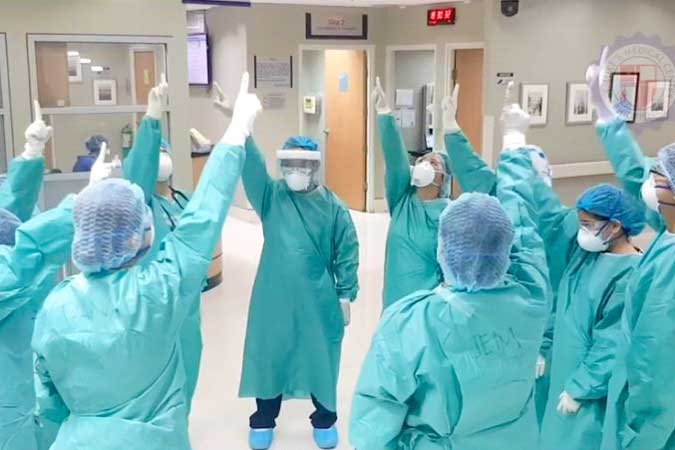Filipino nurses continue to endure at the frontlines

By Brontë H. Lacsamana
MA. MARTINA GERALDINE “Gigi” Q. Dimalibot, St. Luke’s Medical Center (SLMC) chief nursing officer, has witnessed the coronavirus disease 2019 (COVID-19) tragedy up close, albeit through multiple layers of personal protective equipment. Nurses like her spend their entire shift dressed in bunny suits, which, though life-saving, are uncomfortable and hot. The suit makes it difficult to breathe, she said.
“When it started, I was contemplating on how we can prepare for it. What do we communicate to our nurses and the rest of our associates? How do we protect them while they will be taking care of our patients?,” Ms. Dimalibot said of the COVID-19 pandemic in a statement.
Despite risking their lives, nurses have been discriminated against, with people painting them as infected and avoiding them outside of their workplace.
Nurses all over the world are suffering from burnout or psychological stress, according to the International Council of Nurses (ICN). A survey conducted by the ICN in 2020 showed that over 70% of national nurses’ associations worldwide claimed their nurses were “subject to violence or discrimination and, as a result of that, concerned about extreme cases of psychological distress and mental health pressure.”
OPTION TO LEAVE
In the Philippines, thousands of healthcare workers go overseas to North America or the Middle East to find jobs with higher pay. In 2020, however, travel restrictions and quarantine guidelines limited their options: a travel ban imposed April of last year ended in November, when President Rodrigo R. Duterte said that 5,000 health workers would be allowed to leave yearly.
The Philippines Overseas Employment Administration said this March that the country would likely hit the deployment limit by this June. “Our projection is by the second quarter, we will be able to reach the ceiling of 5,000 and the Inter-Agency Task Force on Emerging Infectious Diseases (IATF) has to come up with a recommendation if we will be allowed to deploy above the ceiling of 5,000 HCWs,” he said in a virtual forum, adding that 3,000 healthcare workers (HCWs) have been deployed from January to February — almost 99% of those deployed are nurses.
Pre-pandemic data from the Department of Labor and Employment showed that entry-level registered nurses got paid around P8,000 to P13,500 a month. Meanwhile, the pre-pandemic entry-level pay scale overseas was about $3,800 a month in the United States and $4,097 a month in Canada.
Since then, the Philippine government has imposed special risk allowance and active hazard pay to compensate health workers for their hard work and sacrifice. However, this has been continuously delayed, according to Ma. Maristela P. Abenojar, president of Filipino Nurses United (FNU). The starting wage of Salary Grade 15, or P32,000, has also been unevenly implemented.
UNITY DESPITE DISTANCE
The nurses who stayed home did not stay silent in their fight for better pay and working conditions, even with the limitations to come together and organize. FNU, in a recent webinar on nurses’ rights, slammed understaffing and work-overloading practices.
“We’ve heard stories of nurses taking on 36 to 48 straight hours of duty with insufficient overtime pay,” said Noel Nery, executive director of the Pro-Labor Legal Assistance Center, “What happens is they just offset the overwork with rest days.”
One of the union’s plans is to press for further improvement of certain provisions under the currently underway Comprehensive Nursing Law. FNU’s Ms. Abenojar specified that the law should indicate a safe ratio of eight patients to a nurse and a Salary Grade 15 wage requirement for both private and public nurses, among other stipulations.
Another form of collective action that arose during the pandemic was the formation of a coalition that has recommended interventions to help contain the virus. The Health Professionals Alliance against COVID-19 (HPAAC) is composed of 163 medical associations and representing a million nurses among other allied health workers.
In March, the HPAAC supported a tightening of lockdown in response to a spike in cases, maintaining that it was important to avoid hospitals reaching full capacity. That had already occurred last year, which led to the onslaught of nurses, doctors, and other medical professionals taking to social media to express their dismay over the state of Philippine healthcare and to reveal what it was like for them behind-the-scenes.
STRENGTHENING THE PRACTICE
To address the health worker gap, institutions such as Johnson & Johnson Philippines, Inc. and the University of the Philippines-College of Nursing (UPCN) have initiated course programs to properly equip Filipino nurses in this unique situation.
The Nurse LEAD Program, launched this May, is a certificate course program that strengthens Filipino nurses’ competencies. “There is more to a nurse’s role than just providing direct care to patients,” said Sheila R. Bonito, dean of UPCN, “With this program, we want to empower our country’s nurses so that they can comfortably take on leadership, management, and supervisory roles within the health unit, implement programs, and engage in community organizing activities.”
Consisting of both online and face-to-face sessions, the course is slated to cover 160 hours, including an online learning management platform hosted by UPCN and real-life sessions where the nurses will practice in the local public health facilities and communities.
Such initiatives have been deemed essential in the face of worker shortages. Early in May, the Department of Health requested the 2021 Nurses Licensure Examination to be moved to an earlier date due to the need for more frontline nurses.
The Professional Regulatory Commission (PRC) heeded this request, pushing the first batch forward to this July with 9,242 examinees set to participate. (This move came after the PRC postponed the original May dates to November amid a rise in COVID-19 cases.)
With hope, most, if not all, examinees will join SLMC’s Ms. Dimalibot in a noble and necessary profession that has been underappreciated during the pandemic. “Whatever happens, we will never turn our backs on patients who need us,” she said.



